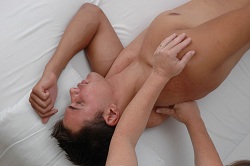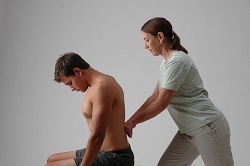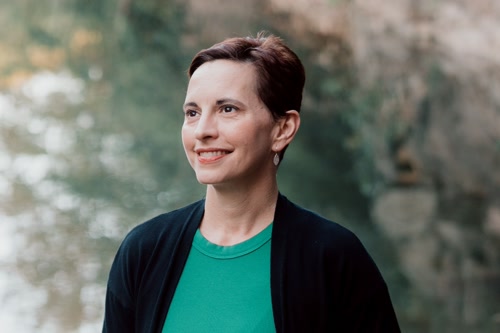Sound Body Somatics
Rolfing® Structural Integration, Movement Education and Somatic Therapy
 Angela Hill
Certified Rolfer™ and Rolf Movement Practitioner™ and LMT
Angela Hill
Certified Rolfer™ and Rolf Movement Practitioner™ and LMT
mobile: 865-255-3834
email: [email protected]
101 Westwood Rd
Knoxville, TN 37919
Angela is not currently taking new clients, but you can contact her at [email protected] to get on her waiting list.
Why the name Sound Body Somatics?
The term "Somatics" comes from the Greek for "soma" or body and refers to an approach to bodywork and movement education that invites conscious relationship with your own body. The field of somatics has some historical roots in Yoga, Tai Chi, Asian martial arts, but usually refers to a wide range of contemporary modalities from movement to body-centered psychotherapy such as The Alexander Technique, Feldenkrais, Bioenergetics, Rolfing®, Continuum, Body-Mind Centering, and Hakomi among others.
I chose the word "sound" for my practice because it conjures up so many images and meanings relevant to this work: vibration, resonance, communication, being heard, depth, inquiry, health, wholeness. A sound body = a sound mind.
I think of my work as a sort of System Integration as I combine elements of Structural Integration (working the restrictions in tissue with Rolfing®), Sensory-motor Integration (working with perceptual and proprioceptive patterning through movement) and Somatic Integration (using Biodynamic Craniosacral and Hakomi Psychotherapy to address the deeper layers).
What is Rolfing®?
Rolfing® is the popular name for Structural Integration bodywork as founded by Dr. Ida P. Rolf. It is a strategic and holistic system of manual therapy and movement education that works with restrictions in tissue and inhibitions in coordination to organize the body in gravity creating the potential for more functional movement patterns.
More information about Structural Integration and Fascia:
Connective tissue or fascia creates continuity throughout the body as it wraps every muscle, nerve and organ and makes up all tendon, ligament and bone. It is organized (or disorganized) in response to gravity, our habitual movement patterns, strain, emotional tension and trauma. With slow and gentile pressure that is applied both strategically and mindfully after a body reading, we can balance the tonus of the fascia thereby assisting the body to achieve greater ease in function, comfort and vitality.
The Ten Series:
The basic series consists of ten sessions in which we are working not only with the connective tissue but also with rhythms of respiration and gait. We also educate the client in ways of using the new possibilities through perceptual movement education. Each Rolfing® session builds upon the results of the previous one, so that the results are cumulative. The first seven sessions remove strain from specific areas of the body: the lower back, neck, knees, etc. the remaining sessions organize and align the body as a whole, resulting in better balance, enhanced freedom of movement, and a higher energy level. It is also possible to do a one-off session or a series of three sessions and still get many benefits from the work.
Rolfing® can help with physical performance as it breaks up adhesions, improves range of motion and alignment. It is particularly useful for the overuse patterns of dancers. You can increase movement potential and energy when you are not doing so much battle with gravity in maintaining the verticality of your structure. Rolfing® also helps with stress and pain management. The process increases body awareness which can have a wonderful effect on how you relate to your environment both inside and out.
A Rolfer starts by evaluating the client's structure through a body reading by watching the client walk usually in their underwear or a two piece bathing suit to fully see the patterns of body usage. The client is then asked to lie on a table, as the Rolfer sensitively applies just the right amount of pressure where the fascia is restricted. The client may be asked to breathe into the area being worked and/or to make synchronized movements. The combination of applied pressure and synchronized response frees and re-positions the connective tissue and aligns the body's segments.
My structural sessions last from 60 to 90 minutes and movement-only sessions are about an hour. The amount of time between sessions varies and is determined on an individual basis. The average spacing is one to two weeks.
 Our work is essentially collaborative, and often clients and therapists find that
it may take more than ten sessions to fully optimize the benefits of a basic series.
The number "ten" is now seen as a traditional guideline in the field with practitioners
sometimes providing 12-15 structural and movement integration sessions over the
course of an initial treatment period. While these basic sessions lay the foundation
for an integrated body structure, many people choose to come in for additional sessions
to continue their healing process or as preventative maintenance. Usually a client
would come for later work after a break for about 6 weeks to several months depending
on their goals and condition. You may find as I did, that you enjoy Rolfing®
so much that you would like to get periodic or even monthly tune ups.
Our work is essentially collaborative, and often clients and therapists find that
it may take more than ten sessions to fully optimize the benefits of a basic series.
The number "ten" is now seen as a traditional guideline in the field with practitioners
sometimes providing 12-15 structural and movement integration sessions over the
course of an initial treatment period. While these basic sessions lay the foundation
for an integrated body structure, many people choose to come in for additional sessions
to continue their healing process or as preventative maintenance. Usually a client
would come for later work after a break for about 6 weeks to several months depending
on their goals and condition. You may find as I did, that you enjoy Rolfing®
so much that you would like to get periodic or even monthly tune ups.
Additional Information on Rolfing® (see also more info and FAQ below)
- Visit The Rolf Institute: http://www.rolf.org/about or The Australian Rolfing® Group www.rolfing.org.au
- Rolfing® was a recent topic on Oprah! Dr. Oz outlined the Medical Benefits of Rolfing® and participated in a Rolfing® Demonstration: http://www.oprah.com/health/Your-Questions-Answered
About Angela:
 Angela Hill is a Certified Rolfer™, Rolf Movement Practitioner™, somatic therapist,
movement educator and mother. She has a BFA in dance education and a background
of fifteen years as a dancer, choreographer and teacher of movement to people of
all ages and abilities. Angela has been practicing manual therapy for the last six
years. She studied Rolfing® in Boulder, Colorado, Sydney, Australia and Barra
do Sahy, Brazil with the top international Rolfing® faculty. She has trained
in the Hakomi Method of Experiential Psychotherapy which supports the mind-body
aspect of her work. Angela's approach is also informed by her experience with other
modalities such as Ideokinesis, Body-Mind-Centering, Laban Movement Analysis, Bartenieff
Fundamentals, Contact Improvisation, Shiatsu, Yoga and Energetic Healing. She is
currently a student of Biodynamic Craniosacral with Terry Collinson of Stillness
Trainings and has just completed a course in the Body-Mind-Centering Basic Neurological
Patterns of movement.
Angela Hill is a Certified Rolfer™, Rolf Movement Practitioner™, somatic therapist,
movement educator and mother. She has a BFA in dance education and a background
of fifteen years as a dancer, choreographer and teacher of movement to people of
all ages and abilities. Angela has been practicing manual therapy for the last six
years. She studied Rolfing® in Boulder, Colorado, Sydney, Australia and Barra
do Sahy, Brazil with the top international Rolfing® faculty. She has trained
in the Hakomi Method of Experiential Psychotherapy which supports the mind-body
aspect of her work. Angela's approach is also informed by her experience with other
modalities such as Ideokinesis, Body-Mind-Centering, Laban Movement Analysis, Bartenieff
Fundamentals, Contact Improvisation, Shiatsu, Yoga and Energetic Healing. She is
currently a student of Biodynamic Craniosacral with Terry Collinson of Stillness
Trainings and has just completed a course in the Body-Mind-Centering Basic Neurological
Patterns of movement.
Angela's philosophy is that our many layers of being - structural, functional, emotional and energetic can come into better resonance and alignment when we can be present in our bodies, integrating both past experiences with new possibilities.
"Behind every tension is a belief"
Ron Kurtz, Founder The Hakomi Method of Experiential Psychotherapy
"The way you walk across a room is the way you walk through life."
Dr. Ida P. Rolf, Founder The Rolfing®Method of Structural Integration
About Rolf Movement Integration:
Rolfing® Movement is based on the concepts and principles of Ida P. Rolf's work and RMI practitioners are certified by the Rolf Institute. We work with a holistic vision of function in gravity that honors the integrative potential of the client and the ability to adapt to their environment. It is about relationships between planes in space, perception and proprioception, self and others, verticals and horizontals and current and past patterns of function. The RMI practitioner works with a combination of touch, language and education resulting in the client's experience of moving with greater ease, elegance and freedom of expression. Angela's approach to movement education is informed by her many years as a dancer and dance educator as well as extensive experience in multiple somatic movement modalities and practices. She is particularly interested in developmental movement and how our earliest learning and movement experiences influence our patterns for life. She has recently completed a course in the Body-Mind-Centering Basic Neurological Patterns of movement. Movement education is done as individual sessions or group classes and is also included as an integral component of the Structural Integration sessions.
About Biodynamic Craniosacral Therapy:
Biodynamic Craniosacral therapy gently assists the body's natural capacity for self-repair and re-organise. It is beneficial in treating a wide range of conditions and can bring about profound healing at all levels: physical, mental, energetic and emotional. It is deeply relaxing and can enhance physical vitality and well being. It can aid in pain relief and encourages the nervous system, organs and musculoskeletal system to balance and heal. The work uses gentle and receptive touch and is directed by the client's system. The therapist tunes into what is happening in the body and can "listen" for contractions and restrictions held in the tissues and fluids of the body. Biodynamic Craniosacral therapy resonates with our innate impulse toward healing and can facilitate lasting change. It also works well with trauma to create a safe resolution of shock and held experiences. It can help a woman's body adjust to the changes of pregnancy and to bring about a harmonious relationship with her body as she prepares for birth. The work is very helpful for babies to relieve the compression and restrictions they may have experienced prenatally and during birth.
As a student of Biodynamic Craniosacral Therapy I see clients for "practice sessions" to fulfill my certification requirements. I also like to either begin or end my Structural Integration and Movement Education sessions with craniosacral contact as a way to tune into the deeper needs of a person's system and help them integrate new patterns.
About Hakomi Somatic Psychotherapy:
In addition to my Rolfing® qualification, I have completed a three year
professional
training in the Hakomi Method, a body-centered, mindfulness based form of somatic
psychotherapy. This method sees individuals as self-organising systems that contain
within themselves their own blueprints for growing and becoming.
The Hopi meaning of Hakomi - ‘How do you stand in relation to these many realms?'
(or more colloquially, ‘Who are you?') reflects the method's emphasis on self study.
The Hakomi client is encouraged to study the organisation of their experience –
how they meet the world, what kind of world they perceive, what beliefs they hold
about themselves and so on.
In Rolfing® we talk about meeting the client at their "layer of availability" which can both refer to their comfort level in the depth of pressure as well as what they are seeking in terms of understanding how their inner experience impacts their movement, postural patterns and tissue organization. I see clients who are interested in Rolfing® to improve their physical performance or to simply enhance their appearance, but I am also open to supporting the organization of the total human being by integrating Hakomi principles and methods where and when appropriate. I find that this is most useful in the movement education components where the story behind the habitual patterns can be organically revealed or when it is helpful to look at the meaning behind the movements in order to more fully integrate new possibilities. On the table, Hakomi can help to provide safety within the therapeutic relationship in moments of emotional release that sometimes occur when an intensely held tissue learns to let go. We can discuss if and how Hakomi might support your Rolfing® work and continue to revise our plan in accordance with your comfort level and goals.
You can read more about Hakomi here: http://www.hakomi.com.au/about.php?top=about
Benefits of Rolfing®:
People seek Rolfing® as a way to reduce pain from overuse and previous injury and to counter the effects of chronic stress and emotional trauma on the body. Many professional athletes, dancers, and entertainers use Rolfing® to improve their performance. It is also useful in addressing repetitive strain injuries. Based on the mind/body connection, many counselors and therapists are incorporating Rolfing® in the therapeutic approach. Outcomes include greater structural support, flexibility, pain reduction and management, mind-body awareness, increased energy levels, greater range of motion, increased breathing capacity, and improved posture. Although Rolfers do not attempt to cure a particular physical problem, many people claim relief is obtained from chronic back conditions as well as from neck, shoulder, joint pain and other conditions where structure is an integral component. Many clients feel that besides feeling physically stronger and energetic, they also feel more confident and balanced in both mind and body.
Development of the Method:
Rolfing® was originated by American biochemist, Ida P. Rolf, Ph.D. (1896-1979), who discovered in the 1930s that the body's fascia, or network of connective tissue that encases and connects all muscles and bones, could be manipulated and actually reshaped. Reshaping was necessary, she argued, since the body eventually gets pulled out of alignment by the effects of gravity. When this occurs, it is the muscles rather than the bones that bear the weight of gravity, and over time the body's fascia or connective tissue loses some of its pliability and becomes thickened and hardened. Eventually they act more like binding straps and the muscles atrophy, or shrink. Ida Rolf believed that unbalanced body was "at war" with gravity thereby expending unnecessary energy.
FAQ
Does Rolfing® Hurt?
Ask people what they have heard about Rolfing® and most will tell you 'it hurts'. This reputation for being painful comes from the early years of Rolfing®. Today, Rolfers realize that change happens more effectively if the body is not tensing in response to pain. I find that I can maximize the benefits of the work by going to the depth of the client's comfort level and by connecting with the tissue slowly and mindfully.
How is Rolfing® different from the work of Chiropractors, Massage Therapists, Osteos and Physios? Massage Therapists generally focus on helping groups of muscles relax whereas Rolfers work with the connective tissue in a strategic way, to support reorganization of the entire body, allowing longer- term results. Chiropractors and Osteopaths work to realign the body through the manipulation of specific joints. Like physiotherapists, they are trained to address specific issues or problems. Rolfing® however, is a holistic system designed to realign the body for better overall posture, function and movement potential. It is not intended to "fix" problems, but may help the body find better support and adaptability to prevent or recover from injuries. Rolfing® can work very well in concert with the treatments you get from a Chiro, Osteo or Physio. When I feel that a client has issues beyond the scope of my training, I refer them to one of the above. I have also had Chiropractors and Physiotherapists refer clients to me for how Rolfing® complements their work or even come and see me for their own personal treatment.
Do I Have to Commit to Ten Sessions?
No. While Rolfing® is considered most effective as a whole series, fewer sessions are still beneficial. A client can come on a trial basis for 1-3 sessions to see if they are comfortable with Rolfing®.
Are there any contraindications and can pregnant women or children receive Rolfing®? Rolfing® is not a cure for any particular disease or physical problem, but is rather a systematic approach that attempts to restore balance to the entire body. When delivered by a trained professional, Rolfing® is safe for both adults and children, but is not a substitute for medical treatment.
Rolfing® is contraindicated for people with cancer, Lupus, clotting disorders and some cases of arthritis.
A modified version is used for women who are three or more months pregnant and can be very beneficial for women to prepare the body for conception, ease physical adjustments during the pregnancy, and realign the body after giving birth.
Rolfing® is also wonderful for children of all ages. It has been shown that the stress and physical manipulation that children endure during the birthing process can lead to ear infections, asthma and learning difficulties later in life. Rolfing® releases the stress and physical blockages, allowing children a healthier life and helps prevent future problems.